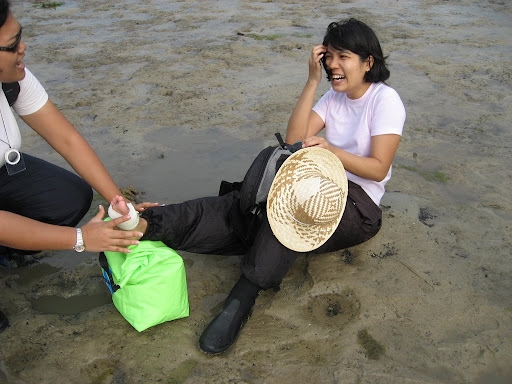Nor Aishah shares her journey with TeamSeagrass and why seagrasses are important.
 |
| Nor Aishah in striped shirt briefing the team at Chek Jawa. |
|
Nor Aishah will be a familiar and reassuring figure to many regulars as she is now the main Seagrass Explainer, giving the pre-monitoring briefings for our trips. Here's Nor Aishah's story, and some parts she didn't quite highlight.
Nor Aishah gives a great briefing regardless of the weather!
 |
| Nor Aishah briefs the team while we wait for the lightning to clear. |
Nor Aishah has been with the team from the very beginning. And in fact, has the added distinction of being our only major incident victim so far. She was stung by a stingray during our first recce trip to Pulau Semakau to set up the transact sites in
Feb 2007. As always, she took it in good cheer and was none the worse for it. Fortunately, this experience has made us super kiasu about safety and so far, touch wood, we have been relatively incident free.
 |
Siti administers first aid to Nor Aishah's stung foot.
Whereupon we abandoned her on the high shore
while we went on with setting up the transacts. A hero indeed! |
Without further ado, here's Nor Aishah's wonderful article...
Watching Seagrass Grow: Reflections of a Volunteer
in
My Green Space Issue 17
 |
| Knobby Sea Stars amid the seagrass at Cyrene Reef – in the background is Jurong Island. |
I first got to know about seagrass in 2002. Then, I was roped in by a friend who was doing a seagrass study during the university term break. The study focused on a meadow of seagrasses on Labrador beach; its objective was to identify the species of seagrass that occurred there and how abundant they were.
What is seagrass?
Seagrass is a group of flowering marine plants that are found in coastal waters down to depths of 50 or 60m. It is found in both tropical and temperate climates. Though the name may indicate otherwise, seagrasses are not true grasses. They are more closely related to the lily family.
 |
| A Peacock Anemone nestled amid the seagrass at Cyrene Reef. |
There are around 60 species of seagrass worldwide. Of these, 12 species occur in the coastal waters off Singapore. Seagrasses are an important source of food for animals such as dugongs and sea turtles. Seagrass meadows are also important nurseries for many marine animals.
 |
| A Grey Bonnet Snail at Cyrene Reef. |
After my brief but memorable encounter with seagrass, it was a natural progression then, for me to join TeamSeagrass when it was formed in 2007. Oh, and that friend who roped me in for the study at Labrador beach? She became the lead scientist for TeamSeagrass.
Who or what is TeamSeagrass?
TeamSeagrass is a collaboration between the National Parks Board’s (NParks) National Biodiversity Centre and Seagrass-Watch. It comprises volunteers from all walks of life and it regularly monitors various seagrass meadows in Singapore.
The main study sites are Chek Jawa, Pulau Semakau and Cyrene Reef. The data collected is submitted to NParks and Seagrass-Watch. This data gives us a better understanding, as well as aids in the management, of Singapore’s seagrasses .
 |
| Volunteers with TeamSeagrass distributing the equipment at Cyrene Reef. |
One common misconception that people have is that Singapore has no wildlife – this is so far from the truth! Though mostly urbanised, there are still areas in Singapore where flora and fauna thrive.
 |
| A Polka-dot Nudibranch at Cyrene Reef. |
One of my favourite sites, Cyrene Reef, is one such place. Surrounded by the Pasir Panjang Container Port, Pulau Bukom and Jurong Island, it is an oasis rich with life. On my trips here, I have seen corals, reef fish, carpet anemones, sea stars, nudibranchs… And the list goes on!
When I share stories and sightings from my seagrass monitoring trips with friends and family, they are amazed at what we can find here. Most of them thought they had to go to other countries to experience these things.
 |
| Replacing the stakes that mark the start of the transects at Pulau Semakau. |
It is for this reason that I believe it is important for groups such as TeamSeagrass to exist. Not only does it provide researchers and organisations looking after our coastal areas with a better understanding of our seagrasses and shores, it also gives the man in the street a chance to experience and learn more about this lesser-known side of Singapore.
I look forward to many more years of good work with TeamSeagrass!
Photos and story by Nor Aishah M. Rashid
Author Note
Nor Aishah M. Rashid is a librarian and nature-lover. As TeamSeagrass’s Top Nerd, she guides newbies in the art of seagrass monitoring. She has been a volunteer with the team since 2007
If you wish to learn more about TeamSeagrass or to volunteer your time,
visit our blog and for more information about seagrasses in Singapore, visit the
Seagrass-Watch page on Singapore.










No comments:
Post a Comment